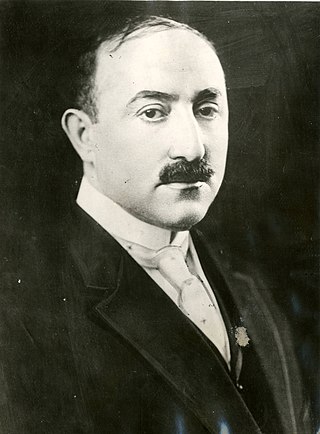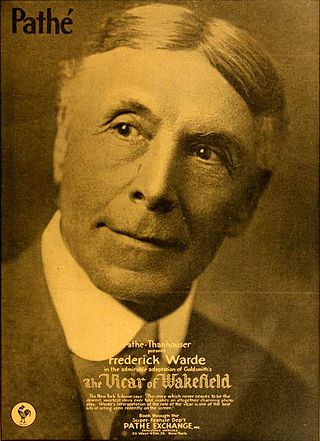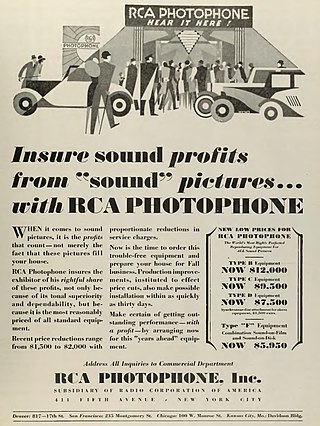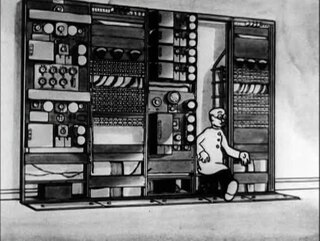Related Research Articles

A silent film is a film without synchronized recorded sound. Though silent films convey narrative and emotion visually, various plot elements or key lines of dialogue may, when necessary, be conveyed by the use of inter-title cards.

The Jazz Singer is a 1927 American part-talkie musical drama film directed by Alan Crosland and produced by Warner Bros. Pictures. It is the first feature-length motion picture with both synchronized recorded music and lip-synchronous singing and speech. Its release heralded the commercial ascendance of sound films and effectively marked the end of the silent film era with the Vitaphone sound-on-disc system, featuring six songs performed by Al Jolson. Based on the 1925 play of the same title by Samson Raphaelson, the plot was adapted from his short story "The Day of Atonement".

A sound film is a motion picture with synchronized sound, or sound technologically coupled to image, as opposed to a silent film. The first known public exhibition of projected sound films took place in Paris in 1900, but decades passed before sound motion pictures became commercially practical. Reliable synchronization was difficult to achieve with the early sound-on-disc systems, and amplification and recording quality were also inadequate. Innovations in sound-on-film led to the first commercial screening of short motion pictures using the technology, which took place in 1923. Before sound-on-film technology became viable, soundtracks for films were commonly played live with organs or pianos.

Wilhelm Fried Fuchs, commonly and better known as William Fox, was a Hungarian-American film industry executive who founded the Fox Film Corporation in 1915 and the Fox West Coast Theatres chain in the 1920s. Although he lost control of his film businesses in 1930, his name was used by 20th Century Fox and continues to be used in the trademarks of the present-day Fox Corporation, including the Fox Broadcasting Company, Fox News, Fox Sports and Foxtel.

Vitaphone was a sound film system used for feature films and nearly 1,000 short subjects made by Warner Bros. and its sister studio First National from 1926 to 1931. Vitaphone is the last major analog sound-on-disc system and the only one that was widely used and commercially successful. The soundtrack is not printed on the film, but issued separately on phonograph records. The discs, recorded at 33+1⁄3 rpm and typically 16 inches (41 cm) in diameter, are played on a turntable physically coupled to the projector motor while the film is projected. Its frequency response is 4300 Hz. Many early talkies, such as The Jazz Singer (1927), used the Vitaphone system. The name "Vitaphone" derived from the Latin and Greek words, respectively, for "living" and "sound".

Sound-on-disc is a class of sound film processes using a phonograph or other disc to record or play back sound in sync with a motion picture. Early sound-on-disc systems used a mechanical interlock with the movie projector, while more recent systems use timecodes.

Sound-on-film is a class of sound film processes where the sound accompanying a picture is recorded on photographic film, usually, but not always, the same strip of film carrying the picture. Sound-on-film processes can either record an analog sound track or digital sound track, and may record the signal either optically or magnetically. Earlier technologies were sound-on-disc, meaning the film's soundtrack would be on a separate phonograph record.

The Movietone sound system is an optical sound-on-film method of recording sound for motion pictures, ensuring synchronization between sound and picture. It achieves this by recording the sound as a variable-density optical track on the same strip of film that records the pictures. The initial version of this system was capable of a frequency response of 8500 Hz. Although modern sound films use variable-area tracks instead, modern motion picture theaters can play a Movietone film without modification to the projector. Movietone was one of four motion picture sound systems under development in the U.S. during the 1920s. The others were DeForest's Phonofilm, Warner Brothers' Vitaphone, and RCA Photophone. However, Phonofilm was principally an early version of Movietone.

Frederick Barkham Warde was an English Shakespearean actor who relocated to the United States in the late 19th century.

RCA Photophone was the trade name given to one of four major competing technologies that emerged in the American film industry in the late 1920s for synchronizing electrically recorded audio to a motion picture image. RCA Photophone was an optical sound, "variable-area" film exposure system, in which the modulated area (width) corresponded to the waveform of the audio signal. The four other major technologies were the Warner Bros. Vitaphone sound-on-disc system, as well as three "variable-density" sound-on-film systems, Lee De Forest's Phonofilm, and Fox-Case's Movietone, and the German system Tri-Ergon.
Phonofilm is an optical sound-on-film system developed by inventors Lee de Forest and Theodore Case in the early 1920s.
The Tri-Ergon sound-on-film system was developed from around 1919 by three German inventors, Josef Engl (1893–1942), Joseph Massolle (1889–1957), and Hans Vogt (1890–1979).

Theodore Willard Case was an American chemist who invented the Movietone sound-on-film system.

Dream Street is a 1921 American silent romantic drama film directed by D. W. Griffith, and starring Carol Dempster, Charles Emmett Mack, and Ralph Graves in a story about a love triangle set in London, and based on two short stories by Thomas Burke, "Gina of Chinatown" and "Song of the Lamp". The cast also features Tyrone Power Sr.

Aubrey Lee Lyles, sometimes credited as A. L. Lyles, was an American vaudeville performer, playwright, songwriter, and lyricist. He appeared with Flournoy E. Miller as Miller and Lyles as a popular African-American comedy duo from 1905 until shortly before his death. in 1929 they appeared on film as grocers in the Vitaphone Varieties short comedy film They Know Their Groceries.

Optical sound is a means of storing sound recordings on transparent film. Originally developed for military purposes, the technology first saw widespread use in the 1920s as a sound-on-film format for motion pictures. Optical sound eventually superseded all other sound film technologies until the advent of digital sound became the standard in cinema projection booths. Optical sound has also been used for multitrack recording and for creating effects in some musical synthesizers.

Fred Van Eps was an American banjoist and banjo maker. The "Van Eps Recording Banjo" was a well-known model until 1930. He was the father of jazz guitarist George Van Eps.

Finding His Voice (1929) is a short film created as an instructional film on how the Western Electric sound-on-film recording system worked. Recording stars Billy Murray and Walter Scanlan, uncredited, provide the speaking and singing voices. Murray also provided the voice for the Fleischer Studios character Bimbo.

Vitaphone Varieties is a series title used for all of Warner Bros.', earliest short film "talkies" of the 1920s, initially made using the Vitaphone sound on disc process before a switch to the sound-on-film format early in the 1930s. These were the first major film studio-backed sound films, initially showcased with the 1926 synchronized scored features Don Juan and The Better 'Ole. Although independent producers like Lee de Forest's Phonofilm were successfully making sound film shorts as early as 1922, they were very limited in their distribution and their audio was generally not as loud and clear in theaters as Vitaphone's. The success of the early Vitaphone shorts, initially filmed only in New York, helped launch the sound revolution in Hollywood.
References
- ↑ The Famous Van Eps Trio in a Bit of Jazz at SilentEra.com
- ↑ Barrios, Richard (13 July 1995). A Song in the Dark. Oxford University Press. p. 15. ISBN 9780195088113.
- ↑ "Griffith to Present Sound Film at Town Hall Tomorrow", The New York Times (May 1, 1921), Drama and Music section, page 78
- ↑ Scott Eyman, The Speed of Sound (1997), page 43